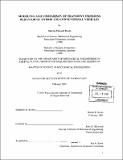Modeling and comparison of transient emissions behavior of hybrid and conventional vehicles
Author(s)
Kosto, Martin Edward, 1977-
DownloadFull printable version (6.971Mb)
Other Contributors
Massachusetts Institute of Technology. Dept. of Mechanical Engineering.
Advisor
John B. Heywood.
Terms of use
Metadata
Show full item recordAbstract
Due to increasing emissions and fuel economy legislation, both in the United States and globally, the search for alternative propulsion systems is escalating. Electric, hybrid gas-electric, fuel cell, and other possible automotive propulsion technologies are continually being evaluated for their merit in a more "environmental society". Investigating these technologies requires both specific evaluation and broad comparative techniques. Currently, most codes associated with hybrid vehicle technology focus on fuel economy, this being the economic driver in the market. Its brother variable, emissions, has been investigated to a lesser degree. Hence, this study will focus on hybrid gasoline-electric system emissions and will examine what determines the magnitude of hybrid emissions and compare these to the emissions of a conventional vehicle of similar scope. Several varieties of emissions estimation methods exist. Many attempt to forecast such levels using a quasi steady-state approach; looking at each time-step independently with no memory of previous results. However, engine transient behavior has a large impact on emissions production. The highest engine-out emissions result from the severe changes in the engine power the vehicle-driving pattern requires. Additional transients occur by a gas-electric hybrid's vehicle constant state of change; turning the engine on and off when necessary. Thus, it is imperative when modeling hybrid vehicle emissions to use a "transient" investigation method. In addition to modeling transient engine (emissions) behavior (modeled as a function of the propellant mixture's air-fuel ratio), a transient catalyst model is included. This allows different control methodologies and improvements in current automobile catalytic converters to be assessed. Such technology is only beginning to be studied and modeled. Yet, it is important to do so, as hybrid technologies will seek to use the best new products available. In conclusion, it is shown that hybrid technology is superior to its conventional counterparts in the emissions arena. Doing so will substantiate criticism of current transportation technologies in favor of new hybrid technology. Modeling results, coupled with real data will substantiate the code and methodology used. Finally, this study gives the reader an improved understanding of the issues associated with hybrid vehicle emissions.
Description
Thesis (S.M.)--Massachusetts Institute of Technology, Dept. of Mechanical Engineering, 2001. Includes bibliographical references (leaf 87).
Date issued
2001Department
Massachusetts Institute of Technology. Department of Mechanical EngineeringPublisher
Massachusetts Institute of Technology
Keywords
Mechanical Engineering.